I am back to Ann Arbor finally. But I have been sick for 2 weeks. Seems every time I go back to China I get sick--no longer used to the polluted air. I had to carry the x-ray of my lungs with me to the airport in case the airlines suspected me having SARS. Funny.
I was in Beijing for 4 days and then went to Zhengzhou to attend a family gathering. After that I flew to Kashgar (Kashi) in Xinjiang and started my Silk Road journey. In the next 11 days I traveled through Turpan, Jiayuguan, Dunhuang, Lanzhou, Xining (Qing Hai Lake), Tianshui, and arrived in Xi'an.
The Silk Road is marvelous. I had heard about it so much before but never imagined it to be so, different. Any traveler would greatly enjoy this part of the world--the driest desert and nothingness, and then civilizations striving and flourishing and lost and rediscovered. I started from the west most part of China--Kashgar (near some *stan countries--Kyrgyzstan, Tajikistan, Kazakhstan, etc. where I would love to visit one day) and took the train eastward back to Chinese civilization. At the beginning of the trip I felt I was in a completely foreign country where nobody spoke any Chinese. One guide book describes Kashgar as the time of 1001 Nights, and it seems true. Kashgar was one of the most rewarding parts of my trip. Going east I saw more and more Chinese influence and I visited places that I read many many times in books and poems and stories when I was growing up. I understood what our ancient poets meant when they talked about desolation and exile.
From the air some of the areas look absolutely like Mars!
Xinjiang from Above
I got sick when I reached Xi'an. I visited my relatives there and then I went to Hong Kong and stayed with my parents. I did not get out of the house (except to see doctors) for a whole week. Afterward, I flew back to the San Francisco, went down to LA to pick up a car, drove back to Michigan. On the way I stopped in the Colorado mountains to visit a friend.
Most of my trip was largely seeing old faces. I counted: since I left Ann Arbor 5+ weeks ago, I had met over 60 old friends and relatives from all the way back to kindergarten days through elementary school, middle school, to graduate school days (my high school and college days were very elusive and left almost no friends). Everyone was happy to see me and wanted to talk to me and I wanted to talk to everyone. I stayed up several nights to talk to friends. Naturally the trip was exhausting and no wonder I got sick.
I took many pictures of the beautiful region I traveled, but sadly I don't have much time to write a travelogue or even write captions to my photos. Lots and lots of stories. Anyhow, with great difficulties I selected 10% of my pictures and put them online, at:
http://caltechc.caltech.edu/~asw/SilkRoad2004/
Next time it is definitely Nepal and Tibet.
9/30/2004
9/28/2004
驾车横跨美国 Cross-Country on a Saab
Coming back from the Silk Road of China, I stopped by Los Angeles and picked up a car from my friend Jason. My plan was to drive this 1993 Saab back to Michigan, stopping by my friend Josh's cabin in a Colorado forest. Here is a photologue of the road trip. All photos were taken from the car unless otherwise noted.

This is a photo of the Saab, from the window and porch of Josh's cabin in the Pike National Forest in Colorado.

Leaving Los Angeles in the afternoon, the desert of Nevada before reaching Las Vegas.
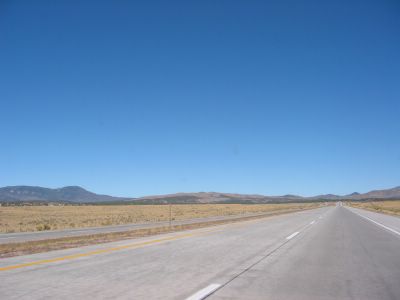
Day 2 late morning, leaving Beaver, Utah, going north on I-15 before turning east on I-70. According to the map, this section is "Black Rock Desert" and "mineral Mountains".

Turning from I-15 onto east bound I-70, this is somewhere near "Fishlake National Forest".

Sweeping landscape of Utah. I decided to take a detour on Hwy 24 (parallel to I-70) towards Capitol Reef National Park.

Landscape near Capitol Reef National Forest, from Hwy 24.

I stopped the car and took this roadside photo in Capitol Reef National Park, by Highway 24.

Another roadside wonder--Petroglyph in Capitol Reef National Park, Hwy 24.

The petroglyph rock in Capitol Reef National Park, roadside of Hwy 24, Utah.

Leaving Capitol Reef National Park, continue on scenic Hwy 24 toward I-70, I came across this interesting landscape.

I stopped the car and took a picture of this interesting landscape, by Hwy 24, Utah.

Cattles in the desert, by Hwy 24, Utah. This is San Rafael Reef on the map.

Another Utah landscape by Highway 24 near I-70. San Rafael Reef area.
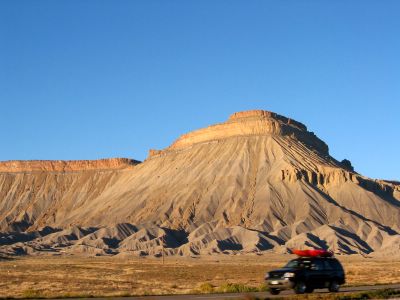
Interstate 70, between Utah and Colorado.

Entering Colorado on interstate highway 70. I took this photo of the almost-full moon out of the Saab sunroof, using with my Canon Powershot S40 point-and-shoot digital camera while driving 75+ mph. Amazing it turned out recognizable!

Looking out from Josh's cabin window in Pike National Forest near Buffalo Creek, beautiful of Colorado.

Josh's cabin in the Pike National Forest near Buffalo Creek, Colorado. Isolated, quiet, and utterly beautiful. Josh was applying to become a cop.
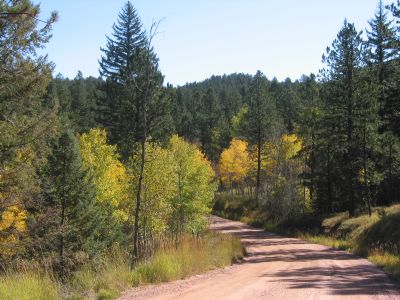
Coming out of Josh's Colorado cabin, one has to go down this dirt road 126. The colors of the fall is glittering under the sun.

From 126, I got on Highway 285 going down the mountain toward Denver. This area of the forest was on fire a couple of years ago.

From Highway 285 looking down a Colorado valley. In the distance there are snow-covered peaks, some fourteeners.
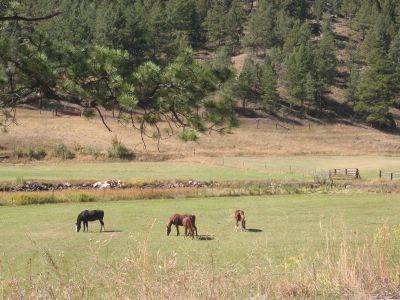
Colorado (from Highway 285).
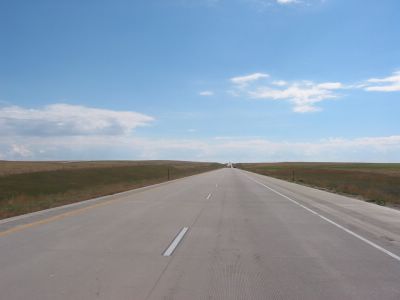
After Denver, all is flat and straight now. Interstate highway 70 east bound, the section between Colorado and Kansas.

Beautiful Kansas early afternoon. Interstate 70.

I-70 Kansas, one hour later. Only the clouds had changed.

This photo of the setting sun was taken on the highway I-70 in Kansas (still!), through the sunroof of a fast moving Saab, using Canon Powershot s40.

Kansas and Missouri were one of the last 10 states I hadn't visited in the US. I had to take a detour through these two states on my way back to Michigan. Here's the proof that I had been to Missouri. :)
After Missouri, I went through Indiana and back to Michigan. The weather was not good so I did not take any more photos....

This is a photo of the Saab, from the window and porch of Josh's cabin in the Pike National Forest in Colorado.

Leaving Los Angeles in the afternoon, the desert of Nevada before reaching Las Vegas.

Day 2 late morning, leaving Beaver, Utah, going north on I-15 before turning east on I-70. According to the map, this section is "Black Rock Desert" and "mineral Mountains".

Turning from I-15 onto east bound I-70, this is somewhere near "Fishlake National Forest".

Sweeping landscape of Utah. I decided to take a detour on Hwy 24 (parallel to I-70) towards Capitol Reef National Park.

Landscape near Capitol Reef National Forest, from Hwy 24.

I stopped the car and took this roadside photo in Capitol Reef National Park, by Highway 24.

Another roadside wonder--Petroglyph in Capitol Reef National Park, Hwy 24.

The petroglyph rock in Capitol Reef National Park, roadside of Hwy 24, Utah.

Leaving Capitol Reef National Park, continue on scenic Hwy 24 toward I-70, I came across this interesting landscape.

I stopped the car and took a picture of this interesting landscape, by Hwy 24, Utah.

Cattles in the desert, by Hwy 24, Utah. This is San Rafael Reef on the map.

Another Utah landscape by Highway 24 near I-70. San Rafael Reef area.

Interstate 70, between Utah and Colorado.

Entering Colorado on interstate highway 70. I took this photo of the almost-full moon out of the Saab sunroof, using with my Canon Powershot S40 point-and-shoot digital camera while driving 75+ mph. Amazing it turned out recognizable!

Looking out from Josh's cabin window in Pike National Forest near Buffalo Creek, beautiful of Colorado.

Josh's cabin in the Pike National Forest near Buffalo Creek, Colorado. Isolated, quiet, and utterly beautiful. Josh was applying to become a cop.

Coming out of Josh's Colorado cabin, one has to go down this dirt road 126. The colors of the fall is glittering under the sun.

From 126, I got on Highway 285 going down the mountain toward Denver. This area of the forest was on fire a couple of years ago.

From Highway 285 looking down a Colorado valley. In the distance there are snow-covered peaks, some fourteeners.

Colorado (from Highway 285).

After Denver, all is flat and straight now. Interstate highway 70 east bound, the section between Colorado and Kansas.

Beautiful Kansas early afternoon. Interstate 70.

I-70 Kansas, one hour later. Only the clouds had changed.

This photo of the setting sun was taken on the highway I-70 in Kansas (still!), through the sunroof of a fast moving Saab, using Canon Powershot s40.

Kansas and Missouri were one of the last 10 states I hadn't visited in the US. I had to take a detour through these two states on my way back to Michigan. Here's the proof that I had been to Missouri. :)
After Missouri, I went through Indiana and back to Michigan. The weather was not good so I did not take any more photos....
9/14/2004
麦积山石窟 Maijishan Grottoes
(This page is under construction.)

Situated 50 kilometres southeast of Tianshui, Gansu Province, the Maijishan Grottoes is a mammoth beehive of temple caves chiselled right into perpendicular cliffs. Construction of the Maijishan Grottoes began in the Late Qin Dynasty of the Period of Sixteen Kingdoms, and, after herculean efforts were made through a dozen dynastic periods, it became one of the country’s largest grottoes. Extolled as a "Museum of the East", Majishan features a total of 194 cave temples divided into eastern and western sections which house 7,200-odd clay and stone sculptures and frescos totalling 1,300 square metres wrought from the late fourth to nineteenth century. The statues, designed to capture the spirit of the figures by means of lifelike imagery, are fine examples of the unique classical Chinese style of clay sculptures.
麦积山石窟。丝 绸之路上重要的宗教艺术古迹,位于甘肃天水县麦积乡南侧,是西秦岭山脉北支小陇山前山区的孤峰,相对高度142米。峰顶呈圆锥 状,红色砂砾岩层略近水平,因岩体形如农村麦垛而得名,为陇原上麦垛式丹霞地貌。山崖拔地而起,高80米,山势险峻,周围绿树成林,环境清幽。

Maijishan Grottoes, Tianshui, Gansu Province.
West of the border with Shaanxi, it is the first significant Silk Road city. Tianshui is just the nearest town to the Maijishan Grottoes, which house amazingly well-preserved Buddhist sculptures in over 200 cliff caves that date back more than 1500 years. Maijishan Grottoes – one of the four largest grottoes in China, catwalks and steep spiral stairs have been built across the cliff face to get access to the caves half way up in the sky.
西汉末年,麦积山已成为天水名将隗嚣的避暑宫。十六国后秦(公元384-417年)时期,始修凿石窟,后经北魏、西魏、北周、隋、唐、五代、宋、元、明、清十多个朝代,1500多年的开凿重修,已成为我国著名的大型石窟群之一。
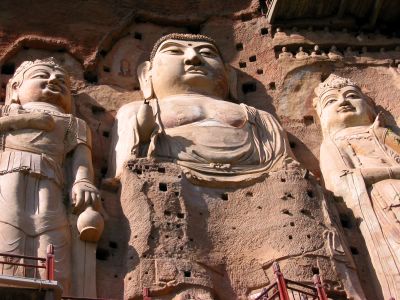
Maijishan Grottoes.
麦积山石窟大佛像。石窟创建于十六国姚秦时期(约384),大兴于北魏太和元年(477)以后,西魏再修崖阁寺宇,北周造七佛阁,隋初建舍利塔,又于七佛阁下雕出高达15米的摩崖大石佛三身,为麦积山最大雕像。

Statues of Maijishan Grottoes
麦积山佛像。

A statue in Maijishan Grottoes.
麦积山石窟一座小佛像。
麦 积山石窟有洞窟194个,泥塑和石刻造像7200余身,壁画1300多平方米,尤以泥塑艺术见长,被誉为“东方雕塑艺术馆”。麦积山石窟是中国诸多石窟寺 庙中风景最为秀丽的一座,以七佛阁、万佛洞、牛儿堂、寂陵等最为著名。泥塑以形传神,神形兼备,反映的内容具有彻底的世俗和浓厚的生活情趣。塑绘手法是上 彩不重彩,特色显明。

Statue of Maijishan Grottoes, Tianshui, Gansu.
麦积山石窟佛像。

Cave painting of Maijishan Grottoes.
麦积山石窟壁画。
石窟以精美泥塑艺术 著称于世,还有少量石刻像和像碑。 现存窟龛194个,塑像7800身;壁画1100平方米,仅占原 有壁画3/10。

Maijishan Grottoes, Cave 5.
麦积山石窟第五窑。
唐 开元二十二年(734)天水一带发生大 地震,崖面中部塌毁,分窟群为东崖和西崖两部分,即五代时所谓东阁和西阁。唐、五代、宋、元、明、清各代均曾增建重修。东崖以涅□窟、千佛廊、散花楼、上 七佛阁、中七佛阁 和牛儿堂等最为重要,规模宏大;西崖共140窟,最重要的三大窟中以万佛堂最大,天堂洞次之,127号窟最小,皆开凿于6世纪。

Maijishan Grottoes.
麦积山石窟栈道。
石 窟高峻惊险,凌空凿于20~80米的悬崖峭壁上,星罗棋布,层层相叠。有崖阁、摩崖窟、摩崖龛、山楼、走廊及不同类型的窟形与窟龛等。

Maijishan Grottoes.
麦积山石窟栈道。

Maijishan Grottoes, Tianshui, Gansu.
麦积山石窟栈道。
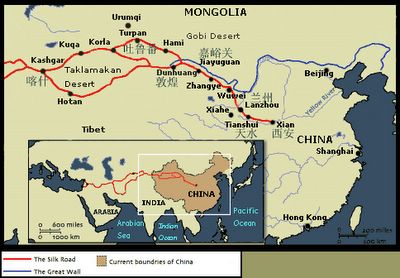
Silk Road map. Maijishan Grottoes is in Tianshui, west of Xi'an.
丝绸之路的地图。麦积山在甘肃省西安以西的天水市。

Situated 50 kilometres southeast of Tianshui, Gansu Province, the Maijishan Grottoes is a mammoth beehive of temple caves chiselled right into perpendicular cliffs. Construction of the Maijishan Grottoes began in the Late Qin Dynasty of the Period of Sixteen Kingdoms, and, after herculean efforts were made through a dozen dynastic periods, it became one of the country’s largest grottoes. Extolled as a "Museum of the East", Majishan features a total of 194 cave temples divided into eastern and western sections which house 7,200-odd clay and stone sculptures and frescos totalling 1,300 square metres wrought from the late fourth to nineteenth century. The statues, designed to capture the spirit of the figures by means of lifelike imagery, are fine examples of the unique classical Chinese style of clay sculptures.
麦积山石窟。丝 绸之路上重要的宗教艺术古迹,位于甘肃天水县麦积乡南侧,是西秦岭山脉北支小陇山前山区的孤峰,相对高度142米。峰顶呈圆锥 状,红色砂砾岩层略近水平,因岩体形如农村麦垛而得名,为陇原上麦垛式丹霞地貌。山崖拔地而起,高80米,山势险峻,周围绿树成林,环境清幽。

Maijishan Grottoes, Tianshui, Gansu Province.
West of the border with Shaanxi, it is the first significant Silk Road city. Tianshui is just the nearest town to the Maijishan Grottoes, which house amazingly well-preserved Buddhist sculptures in over 200 cliff caves that date back more than 1500 years. Maijishan Grottoes – one of the four largest grottoes in China, catwalks and steep spiral stairs have been built across the cliff face to get access to the caves half way up in the sky.
西汉末年,麦积山已成为天水名将隗嚣的避暑宫。十六国后秦(公元384-417年)时期,始修凿石窟,后经北魏、西魏、北周、隋、唐、五代、宋、元、明、清十多个朝代,1500多年的开凿重修,已成为我国著名的大型石窟群之一。

Maijishan Grottoes.
麦积山石窟大佛像。石窟创建于十六国姚秦时期(约384),大兴于北魏太和元年(477)以后,西魏再修崖阁寺宇,北周造七佛阁,隋初建舍利塔,又于七佛阁下雕出高达15米的摩崖大石佛三身,为麦积山最大雕像。

Statues of Maijishan Grottoes
麦积山佛像。

A statue in Maijishan Grottoes.
麦积山石窟一座小佛像。
麦 积山石窟有洞窟194个,泥塑和石刻造像7200余身,壁画1300多平方米,尤以泥塑艺术见长,被誉为“东方雕塑艺术馆”。麦积山石窟是中国诸多石窟寺 庙中风景最为秀丽的一座,以七佛阁、万佛洞、牛儿堂、寂陵等最为著名。泥塑以形传神,神形兼备,反映的内容具有彻底的世俗和浓厚的生活情趣。塑绘手法是上 彩不重彩,特色显明。

Statue of Maijishan Grottoes, Tianshui, Gansu.
麦积山石窟佛像。

Cave painting of Maijishan Grottoes.
麦积山石窟壁画。
石窟以精美泥塑艺术 著称于世,还有少量石刻像和像碑。 现存窟龛194个,塑像7800身;壁画1100平方米,仅占原 有壁画3/10。

Maijishan Grottoes, Cave 5.
麦积山石窟第五窑。
唐 开元二十二年(734)天水一带发生大 地震,崖面中部塌毁,分窟群为东崖和西崖两部分,即五代时所谓东阁和西阁。唐、五代、宋、元、明、清各代均曾增建重修。东崖以涅□窟、千佛廊、散花楼、上 七佛阁、中七佛阁 和牛儿堂等最为重要,规模宏大;西崖共140窟,最重要的三大窟中以万佛堂最大,天堂洞次之,127号窟最小,皆开凿于6世纪。

Maijishan Grottoes.
麦积山石窟栈道。
石 窟高峻惊险,凌空凿于20~80米的悬崖峭壁上,星罗棋布,层层相叠。有崖阁、摩崖窟、摩崖龛、山楼、走廊及不同类型的窟形与窟龛等。

Maijishan Grottoes.
麦积山石窟栈道。

Maijishan Grottoes, Tianshui, Gansu.
麦积山石窟栈道。

Silk Road map. Maijishan Grottoes is in Tianshui, west of Xi'an.
丝绸之路的地图。麦积山在甘肃省西安以西的天水市。
9/10/2004
嘉峪关 JiaYu Pass and the Great Wall
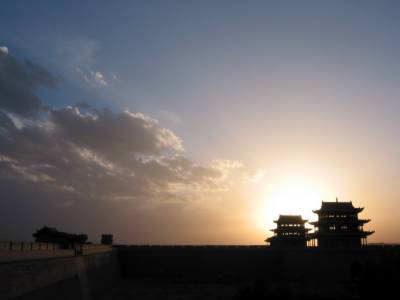
嘉峪关城楼。
JiaYu Pass, City Tower.
JiaYuGuan Pass, known as the Impregnable Pass in the World, is the starting point of the Great Wall in the Ming Dynasty. It has stood tall and upright at the western terminal of Gansu Province for more than 600 years. With smart design and solid construction, the pass used to be a fortified military stronghold. Built in 1372.
嘉峪关在甘肃嘉峪关市西南隅,万里长城西端的终点。建于明洪武五年(1372年),距今600余年。因城在嘉峪山西麓的岩岗处,故名。南 为祁连山,雪峰如玉,绵亘千里;北为龙首山,马鬃山,与祁连山相峙,雄踞河西。关城高踞其间,两侧城墙横穿戈壁,与两山相连。形势险要,自古为军事要地。 关城呈梯形,周长733米,面积33,500平方米,高十米,垛墙高一点七米。东西城垣开门,均筑瓮城,城楼对称,三层五间式,周围有廊,单檐歇山顶,高 十七米。城四隅有角楼,南,北墙中段有敌楼,一层三间式带前廊。两门内北侧有马道达城顶,今已废。西面城垣凸出,中间开门,门额刻“嘉峪 关”三字。原有城楼,与东西二楼形制相同,三楼东西成一线,西有砖砌罗城,东、南、北三面土筑围墙,连接长城。城外有城,重关重城,成并守之势。俗传当年 建关时,匠师计算用料十分精确,竣工只剩一砖。此砖今存西瓮城门楼后檐台之上。西门外,一里处有石碑,上刻“天下雄关”四字;东瓮城外有文昌阁,关帝庙, 戏楼,城内靠北有游击衙门一座,均为清代所建。解放后,多次维修加固,现已对外开放,供人游览。
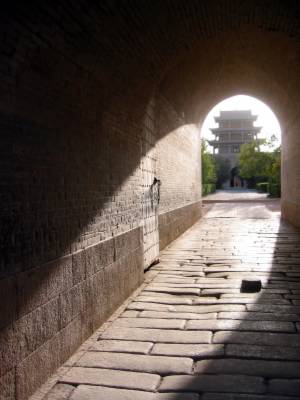
嘉峪关城楼。
JiaYu Pass.
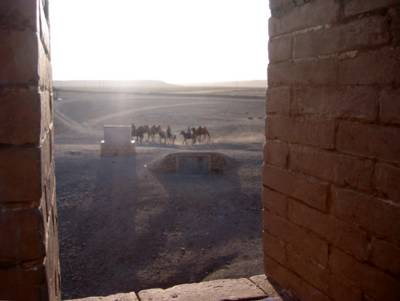
城外骆驼队。
Camels outside the City Wall.
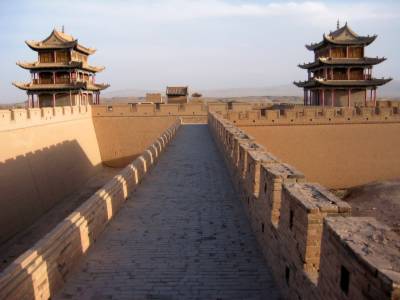
嘉峪关城楼。
City Tower on JiaYu Pass.
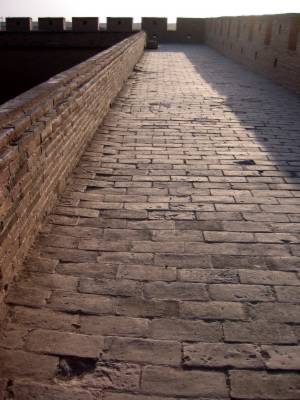
嘉峪关城墙。
City Wall of JiaYu Pass.
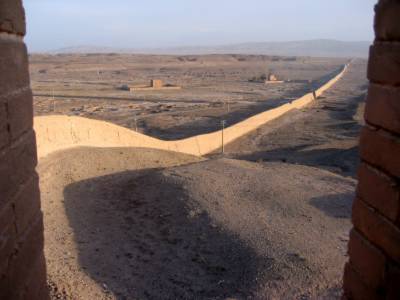
嘉峪关外的长城。
The Great Wall outside JiaYu Pass.
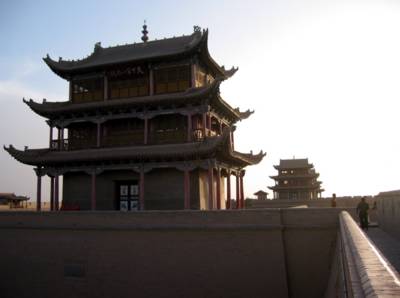
嘉峪关--天下第一雄关。
JiaYu Pass--No.1 powerful pass under heaven.
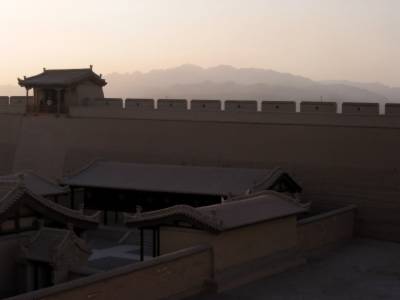
嘉峪关,远山。
JiaYu Pass and distant mountains.
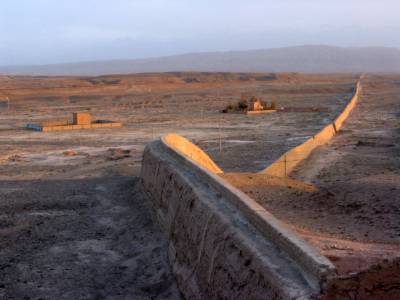
嘉峪关外的长城。
The Great Wall outside JiaYu Pass.
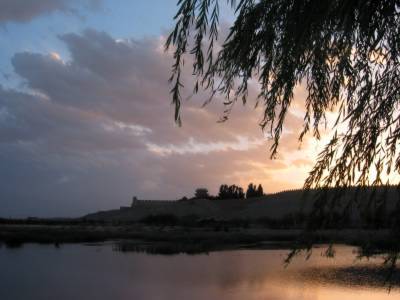
嘉峪关城墙,夕阳西下。
JiaYu Pass, sunset.
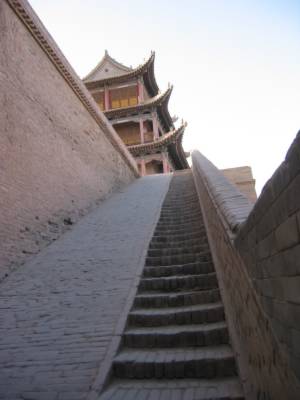
嘉峪关城墙上的楼梯台阶,与波多黎各城堡上的台阶不约而同的设计:台阶走人,斜坡上马。
The stairs of the fort on JiaYu Pass reminds me of the fort in Puerto Rico, where the steps are for people, and the slope is for horses.
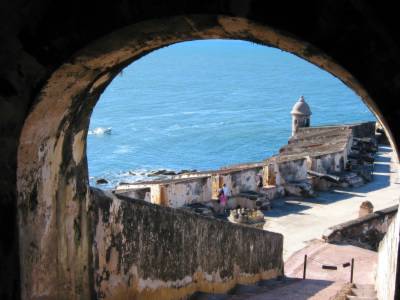
波多黎各的城堡
Fort, San Juan, Puerto Rico.
Subscribe to:
Posts (Atom)
